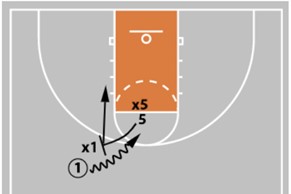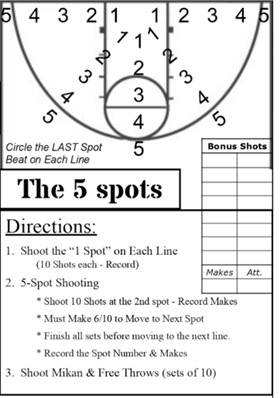How to Use Game-Based Drills to Teach Better Offense, Make Practice Fun, Increase Engagement, and Shoot Better In Games
"My practices aren't designed for your enjoyment."
- Norman Dale
"Everyone wants to be on a winning team, but nobody wants to come to practice."
- Bob Knight
Here is what you're going to find throughout this insightful article...
- Summer Workouts: Teaching Offense with Less Than 10 Players (Video of Drills Included)
- "Nobody's Having Fun" - How To Make Practice Drills Fun & Effective! (Even at the Pro Level)
- Shooting Better In Practice But Not Games (The Solution and Drills)
Necessity is the Mother of Innovation
Our transition into a games-based approach over the past eight years is largely the result of both necessity and failure. For many years we used a more traditional approach to skill development and implementing our systems. Unfortunately, over time, it became clear that our methods left something to be desired.
At the time, we faced three significant challenges:
- Our summer workouts often involved fewer than 10 players.
- Our players weren't having fun in practice.
- The improvement we saw in our drills did not transfer to actual games.
When taken together, we knew something had to change.
Summer Workouts: Teaching Offense with Less Than 10 Players (Video of Drills Included)
My transition to a games-based approach occurred while I was coaching the varsity girls' basketball at Springville High School in Iowa. Iowa is the only state in the nation that plays school softball during the summer. Consequently, our players rarely came to open gyms on softball game days, and with JV/V playing on separate days, we rarely had our full team together until the softball season ended.
Our summer workouts have generally had three objectives:
- Shooting & Finishing
- Skill Development
- Offensive Concepts
With less than 10 players in the gym at one time it was nearly impossible to get any live repetitions of 5v5. Rehearsing our offense in 5v0 was often an option - but many of our concepts were predicated on learning to read the defense. We wanted players to recognize vacant space and be able to identify where defenders were positioned before making decisions about how to move. That was nearly impossible to simulate in 5v0.
How can players learn to react to defenders that aren't there?
This challenge prompted our first significant change - we broke the offense down into smaller parts and created small-sided competitive games out of those individual actions. These repetitions were live but were typically limited to only one attack.

For example, because we set a lot of ball screens in the slots we played 2v2 with the post starting above the foul line and the guard with the ball in the slot. The offense would be allowed one action to attack the rim from this angle.
While not a perfect representation of an actual game, we found that we created more opportunities for players to practice decision-making and reacting to live defense.

This action could easily become a 3v3 game by adding a spacer in the corner which created all kinds of new options for the offense. Decision-making became more complex by adding a help-side defender to the drill.
As we continued to build game-like drills that simulated our offense we noticed that our improvement seemed to accelerate likely because we became more efficient.
In 2012, Brian McCormick published a study that compared the number of individual offensive touches per player in 3v3 and 5v5 games. He concluded that players get 80% more opportunities with the ball playing 3v3.
Playing live possessions also allowed our defense to practice defending common actions which meant we were improving on both sides of the ball simultaneously.
Our overall improvement began to accelerate because our players were getting more repetitions by playing small-sided games.
Here is a video of a 2v2 Pick and Roll Drill:
"Nobody's Having Fun" - How To Make Practice Drills Fun & Effective! (Even at the Pro Level)
This was a captains' meeting I would never forget. It was January 2014, and we were right in the middle of the dog days of the high school basketball season. Winter break had come and gone, but the postseason was still weeks away. I didn't realize it at the time, but my team was bored. All I knew was that we weren't practicing very well. There wasn't much enthusiasm and our effort was waning. So I called a captain's meeting to talk things over.
I started the meeting by letting them know I wasn't happy about our lack of energy and attention to detail in practice. At the time, we were a fairly competitive .500 team that on the right night could put a scare into just about anyone on our schedule. We were clearly getting better as the season progressed, but practices had become a grind for everyone and I wanted to know why.
The three captains hemmed and hawed for a few minutes, none willing to answer the question directly. Finally, one of them said five words that would change my approach to coaching from that day forward...
"Coach, nobody's having any fun."
This was news to me. We invested a lot of time preparing for our opponents - watching film, identifying calls and set plays, taking strengths away, etc. We were good at it, and I loved doing it. The chess match was what made coaching fun… for me.
Our players, however, told a different story. They were tired. They were bored. Practice became monotonous as we spent the majority of our time preparing for upcoming opponents and very little time doing anything that was remotely fun for them.
I will be the first to acknowledge that winning is more fun than losing, and I firmly agreed with Bear Bryant who said, "It's the will to prepare to win that matters." However, that conversation with my captains forced me to wrestle with a new question:
Is there a more enjoyable way to prepare?
I had never given much consideration to how much our players actually enjoyed the process. And so, rather than walking through play after play in our pregame practices, we started to let kids play small-sided games that allowed us to defend the common actions we were likely to see from our next opponent.
As practices became more competitive our energy was rekindled. We started to see more enthusiasm and engagement as we progressed through the rest of the season.
While I once planned practice for my enjoyment, we now plan practice for our players' enjoyment.
Here is an example of small-sided game that involves a penetrate and pass or drive and kick situation:
Shooting Better In Practice... But Not Shooting Better In Games (The Solution)

The final straw that propelled me to fully embrace a games-based approach was seven years in the making. When I took the job at Springville High School, we piloted an off-season shooting program called Sniper School. It was a system developed after reading Daniel Coyle's The Talent Code designed to put players at the edge of their shooting ability.
The workout consisted of players shooting "lines" in practice, for example from the basket to the corner, wing, top of the key, etc. We dropped floor spots every four feet along that line. Players started at the One Spot (4') and took ten shots. If they made at least 6/10, they moved to the Two Spot (8') and took ten shots. This process repeated until they got to the Five Spot (3-point line). If a player failed to make 6/10, they repeated the spot. A typical workout included:
5 Lines x 5 Spots x 10 Shots = 250 Shots
They would achieve a score for the workout based on the last shot they beat (made 6/10) from each line. This allowed us to calculate their "60% range" and score the workouts over time. We use the following formula to calculate their range.
Sample Workout:
Right Baseline
Right Wing
Middle
Left Wing
Left Baseline
3 Spots
4 Spots
3 Spots
5 Spots
4 Spots
Total Score: 19 Spots / 5 Lines = 3.8
60% Range: 3.8 (average score) x 4' = 15.2 feet
We used this system heavily in the off-season and tracked our players from 7th-12th grade during open gym workouts and spring shooting sessions. Over seven years we charted over 125,000 shots and we found that the more players shot in Sniper School the more their scores and 60% range improved over time. We even incorporated their Sniper School stats into our shot selection conversations during the season so that their "3-point license" had to be earned in the off-season.
In 2015, we had a senior that was poised for a breakout season. She had toiled in Sniper School since 7th grade, and during the previous off-season shot over 54% from behind the 3-point line during our workouts. She had earned her 3-point license, and had high expectations for herself.
Despite her success in Sniper School, she shot only 29.3% (24-82) from behind the 3-point line during her senior season.
These results were a mystery that we quickly dismissed as a statistical aberration. Surely her lack of success was due to her slow release, subpar athleticism, or an inability to make contested shots in game play. We thought nothing more of it and continued with Sniper School for another off-season.
Then it happened again.
Another senior with six years in the program who shot over 52% from the 3-point line in her workouts shot 13% (3-23) from behind the arc during her senior season!
This caused us to start asking more difficult questions about Sniper School. Why wasn't our success in Sniper School transferring to game competition?
Around the same time I read Brian McCormick's book The 21st Century Basketball Practice where he discusses some of the variables in training that affect the transfer of skills to actual games.
For the first time I recognized the differences between the shots we took thousands of times in Sniper School and the shots we were taking in games...
- Game shots are random
- Game shots are contested
- Game shots are never taken from the same spot twice in a row
- Game shots require players to set their feet before every shot
We simulated none of these things in Sniper School.
Consequently, we got better at the drill... but were no better in games.
And so we started to explore a different way to train.
For the past six years we have been on a journey experimenting with game-based drills - searching for better ways to simulate game-like skill development during our practices and off-season workouts.
That's why we created the Game-Based Training System for Individual Skill Development.
This package includes over six hours of video demonstrating how we teach our players passing, ball-handling, decision-making, and shooting in a games context. It includes an ebook with over 125 pages of diagrams, philosophy, and instruction on how to use these drills with players of all ability levels so that you can provide the appropriate challenge for every player in your program.
This system offers a comprehensive look at how to build your skill development using game-based drills that simulate the same situations, defensive angles, and scoring opportunities that your players will find in games.
We want to equip you to help your players develop skills that will transfer to their in-game performance. Click on the link for more information and sample videos from Sanderson's Game-Based Training System.
What do you think? Let us know by leaving your comments, suggestions, and questions...
|
|||||||



 Facebook (76k Likes)
Facebook (76k Likes) YouTube (85k Subscribers)
YouTube (85k Subscribers) Twitter (26k Followers)
Twitter (26k Followers) Q&A Forum
Q&A Forum Podcasts
Podcasts